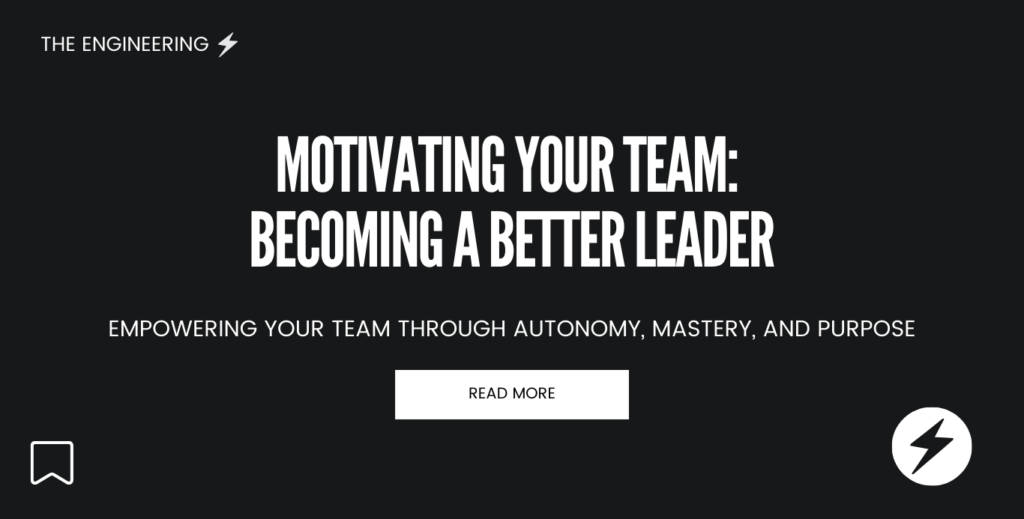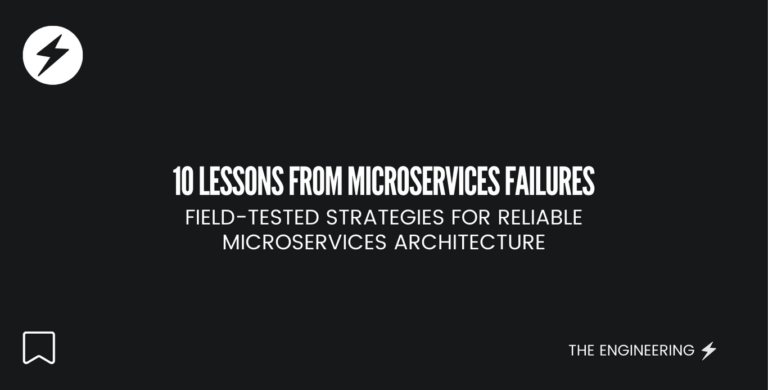
Motivation is a core principle and driver for many Engineering teams. When it comes to motivating your team, in my past experience, I have seen the Good, Bad and Ugly of both high-performing teams and teams that are struggling to drive and deliver results due to low motivation or cohesion.
Navigating the complexities of team dynamics often leads to the question of how best to inspire and motivate. The conventional carrot-and-stick approach—rewarding success and penalizing failure—falls short of nurturing genuine motivation and can even stifle innovation and engagement.
The secret to unlocking a team’s full potential lies in leveraging intrinsic motivation, a concept beautifully articulated in Daniel Pink’s book “Drive“. Pink proposes that the most profound motivation stems not from external incentives but from within, driven by our inherent need for autonomy, mastery, and a sense of purpose.
The Building Blocks
Autonomy: The Power of Self-Direction
Autonomy is about empowering team members with the freedom to shape their work environment and approach to tasks. This empowerment can range from choosing their projects and work schedules to selecting team members. Transitioning to a results-oriented work environment (ROWE) puts the focus squarely on outcomes rather than the minutiae of the work process. Fostering a sense of ownership and responsibility.
Mastery: The Pursuit of Excellence
Mastery, the inherent desire to improve, is a powerful motivator. It’s about providing team members with “Goldilocks tasks”—challenges that are neither too easy nor insurmountably hard but are perfectly calibrated to stretch their capabilities and encourage growth. This pursuit of excellence is a journey, not a destination, and it’s fueled by curiosity, a love for the work, and the satisfaction derived from personal and professional growth.
Purpose: Connecting Work to Greater Goals
The quest for purpose is a fundamental human drive. In the modern workplace, aligning individual aspirations with the organization’s broader objectives can transform routine tasks into meaningful contributions. This alignment can be achieved through frameworks like Objectives and Key Results (OKRs). By utilizing OKRs, individuals can see how their efforts contribute to the organization’s success and, consequently, to a larger societal impact. This clear connection between personal goals and broader missions fosters a sense of purpose and fulfilment.
Elevating Team Performance
These three pillars underpin any team and instil a sense of drive for both teams and individuals. First, we all want to contribute to the greater good, feeling that our efforts have a meaningful impact. Next, it is crucial to feel empowered to drive results, as it fosters a sense of capability and influence over outcomes. Finally, experiencing a sense of ownership connects us deeply with the results and impact generated for our end-users or community. Together, these elements create a robust foundation for motivation and engagement.
As thought leaders, we aim to inspire others, shape perspectives, and drive innovation within our fields or organizations. To achieve this, we strive to motivate teams and individuals effectively. Consequently, we must possess interpersonal, strategic, and visionary skills to lead successfully. By combining these skills, we can foster a culture of growth and creativity, ultimately driving our teams toward excellence and sustained success.
Unleashing Team Potential
In the dynamic landscape of modern workplaces, the role of a leader transcends beyond mere supervision to become a catalyst for team growth, innovation, and cohesion. A holistic leadership approach that incorporates setting clear goals, providing feedback, nurturing a positive environment and more can amplify team potential. Here’s how leaders can integrate these facets to foster high-performing and motivated teams.
Set Clear Goals and Expectations
The foundation of a high-performing team is clarity in goals and expectations. Clear objectives guide efforts in the right direction and imbue team members with a sense of purpose.
- Define the Vision: Articulate a compelling vision that ties individual roles to the organization’s broader goals, enhancing the sense of purpose and direction.
- Employ the SMART Framework: Utilize Specific, Measurable, Achievable, Relevant, and Time-bound criteria to ensure goals are clear and actionable.
- Customize and Collaborate: Tailor goals to individual strengths and preferences and involve team members in goal-setting to foster ownership and commitment.
Provide Regular Feedback
Feedback is the cornerstone of growth and improvement. Regular, constructive feedback nurtures a culture of continuous learning and adaptability.
- Enhance Growth: Offer specific, actionable feedback that focuses on behaviours and skills, encouraging personal and professional development.
- Build Trust: Use feedback sessions to strengthen relationships, showing genuine interest in team members’ growth and well-being.
- Acknowledge Achievements: Recognize and celebrate successes, reinforcing positive behaviours and boosting team morale.
Foster a Positive Work Environment
A nurturing work environment is pivotal for team engagement and creativity. It’s where respect, support, and collaboration flourish.
- Promote Open Communication: Encourage transparent and respectful communication, ensuring every voice is heard and valued.
- Cultivate Respect and Support: Build a mutual respect and support culture where diversity is celebrated and team members feel valued.
- Ensure Work-Life Balance: Advocate for a healthy balance, recognizing the importance of rest and personal time in sustaining long-term productivity and creativity.
Encourage Professional Growth
Investing in the professional development of team members not only enhances their skills but also signals trust in their potential.
- Provide Learning Opportunities: Offer access to training, workshops, and seminars that align with individual career aspirations and organizational needs.
- Support Career Advancement: Help team members chart a path for career progression, showing commitment to their long-term success.
- Celebrate Educational Achievements: Recognize and reward efforts towards gaining new skills and qualifications, reinforcing the value placed on continuous learning.
Empower Your Team
Empowerment fosters innovation and ownership. Leaders can unlock their full creative and problem-solving potential by trusting team members with autonomy.
- Grant Autonomy: Allow team members to take charge of their projects and decisions, fostering a sense of ownership and accountability.
- Encourage Initiative: Motivate team members to propose new ideas and solutions, creating a culture where innovation is celebrated.
- Provide Resources and Support: Ensure team members have the tools and support to leverage their autonomy successfully.
Lead by Example
Leadership is as much about actions as it is about directives. Modelling the behaviour and work ethic expected from the team sets a high standard and builds credibility.
- Demonstrate Integrity: Show consistency between words and actions, reinforcing trust and respect among team members.
- Exemplify Work Ethic: Display commitment and dedication, inspiring the team to mirror these qualities in their own work.
- Embody Organizational Values: Live the organisation’s core values, serving as a tangible example for the team.
Facilitate Team Building
Strong relationships are the bedrock of effective collaboration. Leaders can enhance the team’s understanding, trust, and cohesion through team-building activities.
- Improve Communication: Use team-building exercises to strengthen communication skills, making collaboration more effective and enjoyable.
- Build Trust and Relationships: Create opportunities for personal interaction and shared experiences, deepening bonds and fostering a supportive team environment.
- Boost Morale and Engagement: Engage the team in fun and meaningful activities. As a result, this will enhance team spirit and overall job satisfaction.
Adapt Your Approach
The hallmark of a great leader is the ability to adapt their leadership style to meet the evolving needs of their team and each individual member. This adaptability ensures the team remains cohesive and effective, even as challenges and circumstances change.
- Recognize Individuality: Tailor your leadership approach to accommodate team members’ diverse work styles, motivations, and needs. Understanding these differences helps in providing personalized support and encouragement.
- Stay Agile: Be open to changing your strategies and techniques as situations demand. This flexibility allows you to maintain effectiveness in a dynamic environment, ensuring the team can navigate uncertainties and changes smoothly.
- Maintain Consistency: Ensure that adaptations in leadership style are grounded in core values and principles. This provides a stable framework within which flexibility can thrive, offering team members a sense of security and continuity.
By embodying these skills, a thought leader can inspire, motivate, and guide teams and individuals towards achieving shared goals and fostering innovation. Thought leadership is not just about having groundbreaking ideas but about bringing those ideas to life in others. This sparks a collective movement towards progress and excellence, transforming visions into reality through collaborative effort and shared enthusiasm.
Frequently Asked Questions (FAQs)
Meta fosters innovation through intrinsic motivation by promoting autonomy, mastery, and a sense of purpose among engineers, aligning individual aspirations with organizational goals.
OKRs help align individual efforts with the organization’s broader objectives, transforming routine tasks into meaningful contributions and enhancing motivation and engagement.
Effective leaders in big tech adapt their leadership style to meet evolving team needs, recognize individuality, stay agile, and maintain consistency in core values, fostering a motivated and cohesive team.





[…] more about Engineering Culture in Meta (Facebook), ⚡Bulletin, Twitter and LinkedIn for more career, leadership, and growth […]
Inspiring a team is akin to being the DJ of good energy—maintain a lively atmosphere, set clear objectives, and cheer for every achievement! An exceptional leader doesn’t just nudge from the back; they lead with enthusiasm, igniting passion in all. 🎶🔥